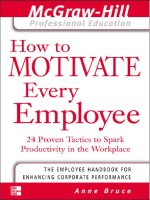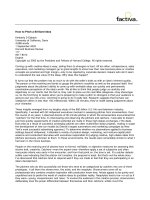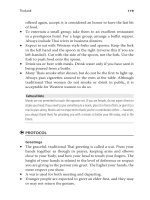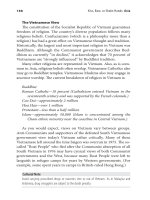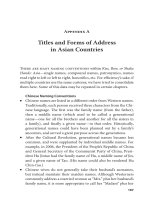Tài liệu HOW TO USE YOUR MEMORY TO EARN MORE MONEY - By Phillip Newton ppt
Bạn đang xem bản rút gọn của tài liệu. Xem và tải ngay bản đầy đủ của tài liệu tại đây (187.29 KB, 30 trang )
Published by Christian H. Godefroy (2001 Christian H. Godefroy.
All rights reserved. No part of this publication may be reproduced,
stored in a retrieval system, or transmitted in any form or by any
means, electronic, mechanical, recording or otherwise, without the
prior written permission of the author.
Manufactured in the United States of America.
HOW TO
USE YOUR MEMORY
TO EARN MORE
MONEY
HOW TO
USE YOUR MEMORY
TO EARN MORE
MONEY
By
Phillip Newton
Page 2Contents
Introduction ........................................................................................................ 3
CHAPTER 1- HOW TO SAVE TIME ............................................................ 4
Do It Right Away! .............................................................................................. 5
How To Solve A Problem.................................................................................. 6
Define The Problem........................................................................................... 6
Analyze The Problem........................................................................................ 6
Weigh the pro’s and con’s, and then ACT!..................................................... 7
Test A ................................................................................................................... 7
Test B.................................................................................................................... 7
CHAPTER 2 - HOW TO MAKE MEMORIZING NUMBERS EASY ..... 9
Numbers ............................................................................................................. 9
Number Series .................................................................................................. 12
How To Remember Lists ................................................................................ 12
Numerical Order Recall .................................................................................. 14
How To Remember Speeches......................................................................... 16
Listening To Speeches ..................................................................................... 17
Learn Things By Heart With Ease ................................................................. 17
Test A ................................................................................................................. 18
Test B.................................................................................................................. 18
Test C ................................................................................................................. 19
Test D ................................................................................................................. 19
Test E.................................................................................................................. 20
Test F .................................................................................................................. 21
CHAPTER 3 - HOW TO REMEMBER NAMES AND FACES .............. 22
What’s His Name? ........................................................................................... 22
What About First Names? .............................................................................. 23
Remembering Faces......................................................................................... 24
No More Telephone Blunders ........................................................................ 25
Remembering Telephone Numbers .............................................................. 25
Stop Forgetting Appointments! ..................................................................... 26
How can you always remember your .......................................................... 26
appointments, without even writing them down? ..................................... 26
Test A ................................................................................................................. 27
Test B .................................................................................................................. 28
Test C ................................................................................................................. 28
CONCLUSION - ETERNALLY YOUNG! .................................................. 29
Contents
Page 3Introduction
Introduction
A little known - and often underestimated - fact is that most people
who succeed in life possess a memory which, although not necessar-
ily phenomenal, is nevertheless above average. Were they born with
this ability, referred to by Plato as “one of the gifts of the gods”?
For the most part, no. They developed their memory by applying
some very simple techniques. This booklet will help you do the same.
The benefits of improving your memory will quickly become
apparent, and are likely to amaze you. They will help you succeed
and prosper. Does this surprise you?
Well, look at a couple of simple examples: a salesman who can
recall the names of his clients with ease has more chance of conclud-
ing a deal, and therefore of increasing his revenues. A company man-
ager who is able to retain figures and repeat them off the top of his
head is more likely to create a favorable impression on the board of
directors, and is more likely to get promoted. Put yourself in his boss’
place: would you want to promote someone who always seems lost,
who has to pore through files for the least bit of information, who
forgets the names of suppliers, and who could very easily forget to
show up at an important meeting?
Whether you work for a small or large company, or whether you’re
your own boss, improving your memory will be of immense service
to you, and not only on a professional level (do you remember the
last time you forgot your spouse’s birthday!).
Distractions and forgetfulness can translate into loss of time and
money. How often do you have to waste time looking for a telephone
number or a file. Time is money, as the saying goes.
Well, put your memory problems behind you. This book will pro-
vide you, in just as few short minutes, with all the tricks and tech-
niques you need to improve your memory and become more suc-
cessful and prosperous!
Page 4Chapter 1
Chapter 1
How To Save Time
One of the easiest ways to remember things is through ASSO-
CIATION. This simply consists of associating whatever you don’t
want to forget with some very unusual, wacky image that will trig-
ger your imagination and implant the memory firmly in your mind.
Obviously if you forget to make the association in the first place
you won’t have much chance of remembering whatever it is you want
to remember! But it’s just a question of habit. Once you know the
technique and have realized just how effective it is by trying it a few
times, you’ll start doing it automatically.
Let’s take an example: you put your watch away, say on a shelf in
your wardrobe. If you don’t want to forget where you it is, try to
imagine your watch floating out of the wardrobe, dressed in a suit of
clothes! Make a real effort to visualize this - you have to really see the
image.
People who habitually misplace things should get into the habit
of always putting objects back where they belong. This will simplify
their lives, since continually having to make associations of this kind
can be confusing.
But let’s get back to the association technique, which is especially
useful when what you have to remember is out of the ordinary. Say
you buy a train ticket and don’t want to lose it. You put it on one of
your bookshelves. To remember where it is, you could visualize hun-
dreds of books getting on the train, or you could imagine that your
bookshelf is transformed into the train itself, and send it speeding off
toward your destination.
Page 5Chapter 1
The effectiveness of the technique is based on that little effort of
imagination which captivates all your attention for a moment. It’s a
way of stimulating your concentration. The mental exercise actually
forces you to be completely present and focussed on what you’re
doing. Make the association at the same time as you put the object
away. It’s important not to put it off for later - later is too late!
Here’s another example: You go to work. Suddenly you remember
that you’re supposed to attend an opening that same night. You must
remember to pick up the invitation before you leave the office. How?
Well, associate the action - trying to make the image as surprising
and unusual as possible - with the last thing you usually pay atten-
tion to before leaving the office in the evening. If you usually look at
the clock, imagine a huge clock rolling into the art gallery and look-
ing at the paintings. Later on, you’ll recall this weird image as you
look at the clock before leaving and, of course, remember your invi-
tation.
While you’re having breakfast you decide that the first thing you
should do when you get to the office is ask your secretary for the
annual sales report. Create a striking image on the spot to help you
remember: for example, imagine that your whole office - the walls,
floors, doors, ceilings, furniture - everything is covered in annual sales
reports. You can then rest assured that when you get to the office,
you’ll immediately think about the sales report.
Do It Right Away!
Every time you think about something you have to do, ask your-
self the question: “Do I have time to do it now?”
If you do, get on with it. If there’s a letter on your desk waiting to
be answered, and you happen to have a few spare moments, don’t
fall into the trap of putting it off for later. Making intelligent use of
your time is the surest way to combat forgetfulness. Get as many things
Page 6Chapter 1
as possible done when the opportunity is there.
Another piece of advice: whenever you remember something
that you should take home with you from the office, put it in your
briefcase right away. Don’t wait for later. If you do, chances are you’ll
forget it, since your mind will be occupied with other things just be-
fore leaving the office. Try to make this a habit - it’ll save you a lot of
headaches!
How To Solve A Problem
You have to make decisions every day, some more important than
others, depending on the situation. However, whatever the problem
is, the better your understanding, the more effectively you can re-
solve it.
If you have all the data you need concerning the problem at hand,
you can resolve it much more easily and quickly. It’s also useful to
know how a similar type of problem was resolved in the past, either
by yourself or by others.
Define The Problem
The first thing to do when a problem arises is to define it as pre-
cisely as possible. Draw up a list of all the essential components you
can think of. When did it start? Under what circumstances? Where?
Sometimes answering these questions is enough to lead you to a so-
lution. Then make a list of possible obstacles to your solution, fol-
lowed by solutions of the obstacles.
Analyze The Problem
You now have a clear picture of the problem. Check to make sure
you haven’t left out any information that might have a bearing on the
situation. If any of your data is vague, take the time to do some more
research and clear it up.
Page 7Chapter 1
Ask yourself what the causes of the problem are: under what cir-
cumstances did it arise? Which people or what factors were involved
in creating the situation? You should look into all possible causes.
Weigh the pro’s and con’s, and then ACT!
You now possess all the information you need to eliminate the
problem. You have your experience and intuition to guide you in your
search for the best possible solution.
After examining the question from all angles, it’s time to concen-
trate your efforts on making a decision, and then to act on that deci-
sion. Determine when your decision will take effect, who will be re-
sponsible for carrying it out, and who the decision will affect, either
directly or indirectly.
Try to make sure that your solution doesn’t cause any new prob-
lems. If this cannot be avoided, try to have solutions already pre-
pared for them.
Here is a quiz to help make sure that you’ve understood the material in
this first chapter. Use a pencil to fill in your answers, or copy the test on
another sheet of paper, so that you can do it again later on.
Test A
Study the following words for 3 minutes, then write them down
in their proper order. Give yourself 10 points for each correct series.
- pineapple, lamp, box, painting, chair, brick
- rope, tree, cake, skirt, pin, notebook
1st try result:
2nd try result:
Test B
Study the following word associations for 5 minutes. Then cover
them and fill in your answers on the opposite page. Give yourself 10
Page 8Chapter 1
points for each correct answer.
grocery - handkerchief
gardening - wood
house - shoe
glass - computer
book - capsule
river - kite
store - screwdriver
daisy - sofa
leaf - biscuit
dessert - coat
computer
book
gardening
kite
biscuit
sofa
shoe
handkerchief
dessert
store
1st try result
2nd try result:
Page 9Chapter 2
Chapter 2
How To Make Memorizing
Numbers Easy
Everyone would like to have phenomenal number recall. We’re
going to take a look at some ways to develop this ability. We’ll also
show you how to make do without an agenda, and how to deliver a
speech without using notes.
Numbers
No matter what kind of work you do, the ability to memorize
numbers is very useful. You may have to remember prices, code num-
bers, file numbers, bids, telephone numbers, etc. But because num-
bers are abstract and have no direct relation to any concrete image,
they are more difficult to remember.
But what if we give numbers an added meaning? Wouldn’t they
become easier to remember? To add to their meaning, we could try to
associate them with letters. We could develop a system where letters,
excluding vowels, are associated with numbers. Look at the example
we have provided below. You can add your own images to the ones
listed. Master the system and experience almost total number recall.
The letter T has one leg, so it represents the number 1. D sounds
a lot like T, so let’s say that D and T represent 1.
The letter N has two legs, and therefore suggests the number 2.
GN will also correspond to 2.
Page 10Chapter 2
The letter M with its three legs refers to the number 3.
For the number 4, we’ll use R. Think about the word fouR, visu-
alizing it for a few seconds.
In Roman numerals, L means 50, so in our system L will be 5.
J has a hook on the bottom, like the number 6. So J represents 6.
The CH sound uses the identical mouth formation as J, but is non-
voiced. So CH will also represent 6.
Add wings to a 7 and you get K. Letters like hard C, Q, and G
resemble the K sound, so they’ll represent 7 as well.
8 resembles a manuscript style F. The letters V and PH resemble
F, so we’ll use them to represent 8 as well.
9 has a loop at the top, and so does P. So P equals 9. B is similar in
sound and also has a loop, B also equals 9.
And finally 0 will be represented by S, by soft C (cedar), by Z and
by X (pronounced as in six).
This gives us the following table:
1 = T D
2 = N GN
3 = M
4 = R
5 = L
6 = J CH
7 = K hard C Q hard G
Page 11Chapter 2
8 = F V PH
9 = P B
0 = S soft C Z X
Only consonants represent numbers, so in the word “consonant”,
only the C, N, S, and T represent numbers, making the word equal to
720221.
Practice the system and try to master it. Try to figure out the nu-
merical values of the following words:
Monday
Paul
certain
break
system
light
rule
guaranty
ANSWERS:
Monday = 321
Paul = 95
certain = 0412
break = 947
system = 0013
light = 51 (G is silent)
rule = 45
guaranty = 7421
Whenever you have a chance, practice converting letters into
numbers. For example, in a doctor’s waiting room try to convert the
Page 12Chapter 2
different signs and magazine headlines into numbers. The speed you
develop will be very useful, as we’ll see later, since this number recall
system is the basis for many other forms of memorization.
Number Series
To remember certain numbers, like your passport or credit card
number, form words which correspond to the number, using the sys-
tem you just set up. With practice, it shouldn’t take you more than a
couple of minutes. So the number 365158419473 could correspond to
the following chain of words (it doesn’t matter how many words you
put in the chain):
my child lover taper chum
You could make a little story out of the words. Try it. Come up
with a story for the series 893193837455. You’ll see that by giving a
more substantial, tangible meaning to numbers, you won’t have any
trouble remembering them.
How To Remember Lists
You probably make lists at home and at work - things you have
to do or buy, people you want to see, etc. Wouldn’t it be better to be
able to store all thins information in your head, instead of always
having to write things down?
I’m going to show you how to do without written lists. Let’s say
that tomorrow you have to do these things:
- hotel (make reservation for business trip)
- file (take home to study)
- Green (call Mr. Green)
- Doctor (appointment)
- watch (pick up at the jeweller’s)
- computer (study for purchase)
- meeting (personnel)
